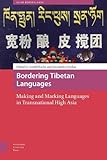Bordering Tibetan Languages : Making and Marking Languages in Transnational High Asia / ed. by Gerald Roche, Gwendolyn Hyslop.
Material type: TextSeries: Asian Borderlands ; 17Publisher: Amsterdam : Amsterdam University Press, [2022]Copyright date: ©2022Description: 1 online resource (218 p.)Content type:
TextSeries: Asian Borderlands ; 17Publisher: Amsterdam : Amsterdam University Press, [2022]Copyright date: ©2022Description: 1 online resource (218 p.)Content type: - 9789048552719
- Borderlands -- Himalaya Mountains Region
- Boundaries -- Social aspects
- Boundaries
- Sociolinguistics -- Himalaya Mountains Region
- Tibetan language -- Social aspects
- AUP Wetenschappelijk
- Amsterdam University Press
- Anthropology
- Asian Studies
- East Asia and North East Asia
- Language Studies
- South Asia
- LANGUAGE ARTS & DISCIPLINES / General
- Himalaya, linguistic anthropology, borders, Tibet
- 495.4 23/eng/20220927
- PL3781 .B67 2022
- online - DeGruyter
| Item type | Current library | Call number | URL | Status | Notes | Barcode | |
|---|---|---|---|---|---|---|---|
 eBook
eBook
|
Biblioteca "Angelicum" Pont. Univ. S.Tommaso d'Aquino Nuvola online | online - DeGruyter (Browse shelf(Opens below)) | Online access | Not for loan (Accesso limitato) | Accesso per gli utenti autorizzati / Access for authorized users | (dgr)9789048552719 |
Frontmatter -- Table of Contents -- Acknowledgements -- About the Cover Image -- 1 Introduction: Bordering Tibetan Languages. Making and Marking Languages in Transnational High Asia -- 2 Playing with Language Boundaries. Heteroglot Standard Language Ideology and Linguistic Belonging among Amdo Children -- 3 The Role of Classical Tibetan (Chöke) on the Development of Kurtöp , a Language of Bhutan -- 4 Reimagining Rongring without Tibetan Buddhist Influence -- 5 Glottonyms, Identity, and Language Recognition in the Eastern Tibetosphere -- 6 On the Yak Horns of a Dilemma. Diverging Standards in Diaspora Tibetan -- 7 Changing Identity and Linguistic Practices in Nubri. Veiled Language Endangerment in the Nepalese Tibetosphere -- 8 Borderline Dominance: Transnational Tibetan Language Politics in the Himalayas -- 9 Borders: In Conclusion -- Tibetan Language Summaries -- Index
restricted access online access with authorization star
http://purl.org/coar/access_right/c_16ec
Bordering Tibetan Languages: Making and Marking Languages in Transnational High Asia examines the complex interactions between state, ethnic, and linguistic borders in the Himalayas. These case studies from Bhutan, China, India, and Nepal show how people in the Himalayas talk borders into existence, and also how those borders speak to them and their identities. These ‘talking borders’ exist in a world where state borders are contested, and which is being irrevocably transformed by rapid social and economic change. This book offers a new perspective on this dynamic region by centring language, and in doing so, also offers new ways of thinking about how borders and language influence each other.
Mode of access: Internet via World Wide Web.
In English.
Description based on online resource; title from PDF title page (publisher's Web site, viewed 25. Jun 2024)


